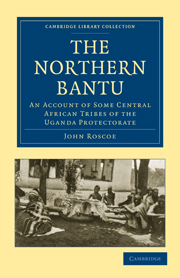Book contents
- Frontmatter
- PREFACE
- Contents
- LIST OF ILLUSTRATIONS
- Uganda and British East Africa
- PART I THE BANYORO A PASTORAL PEOPLE
- PART II THE BANYANKOLE A PASTORAL TRIBE OF ANKOLE
- CHAP. X THE COUNTRY AND PEOPLE
- CHAP. XI GOVERNMENT, CLANS AND TOTEMS, MARRIAGE
- CHAP. XII BIRTH CUSTOMS, SICKNESS, DEATH AND BURIAL
- CHAP. XIII RELIGIOUS BELIEFS, HUNTING, COUNTING AND DIVISION OF TIME, MUSIC AND GAMES
- PART III THE BAKENE, LAKE DWELLERS
- PART IV THE BAGESU A CANNIBAL TRIBE
- PART V THE BASOGA
- PART VI NILOTIC TRIBES. THE BATESO AND THE KAVIRONDO
- INDEX
- PUBLICATIONS OF THE CAMBRIDGE UNIVERSITY PRESS RELATING TO AFRICA
- Plate section
CHAP. XII - BIRTH CUSTOMS, SICKNESS, DEATH AND BURIAL
Published online by Cambridge University Press: 07 September 2011
- Frontmatter
- PREFACE
- Contents
- LIST OF ILLUSTRATIONS
- Uganda and British East Africa
- PART I THE BANYORO A PASTORAL PEOPLE
- PART II THE BANYANKOLE A PASTORAL TRIBE OF ANKOLE
- CHAP. X THE COUNTRY AND PEOPLE
- CHAP. XI GOVERNMENT, CLANS AND TOTEMS, MARRIAGE
- CHAP. XII BIRTH CUSTOMS, SICKNESS, DEATH AND BURIAL
- CHAP. XIII RELIGIOUS BELIEFS, HUNTING, COUNTING AND DIVISION OF TIME, MUSIC AND GAMES
- PART III THE BAKENE, LAKE DWELLERS
- PART IV THE BAGESU A CANNIBAL TRIBE
- PART V THE BASOGA
- PART VI NILOTIC TRIBES. THE BATESO AND THE KAVIRONDO
- INDEX
- PUBLICATIONS OF THE CAMBRIDGE UNIVERSITY PRESS RELATING TO AFRICA
- Plate section
Summary
Midwives and their treatment of patients. Pregnant women have no food restrictions because their food consists of milk only, and a woman takes her usual supplies of milk and continues her ordinary vocations until she is about to be confined. A few days before her confinement she undergoes a process of massage to make her bones supple and thus give her an easy delivery. An elderly woman remains with her some days before the day of birth, and, when she sees the actual labour pains begin, she ties a rope to the roof of the hut for the expectant mother to hold on by while she herself acts as midwife. A second woman supports the mother and encourages her during this time. When the child is born, it is placed on the floor on a small cow-skin, and respiration is set up by the midwife who rubs the child's eyes, head, face and nose. She puts a large thorn of an acacia tree into the child's mouth, because it is said to make the breath sweet. When the placenta comes away, the umbilical cord is cut with a strip of wood taken from a drinking-tube. A hole is dug in the doorway of the hut, lined with sweet smelling grass, and the placenta buried in it. Mothers dislike a child to be born feet first, because they fear the child will grow up to be troublesome and unsatisfactory.
- Type
- Chapter
- Information
- The Northern BantuAn Account of Some Central African Tribes of the Uganda Protectorate, pp. 123 - 130Publisher: Cambridge University PressPrint publication year: 2010First published in: 1915



